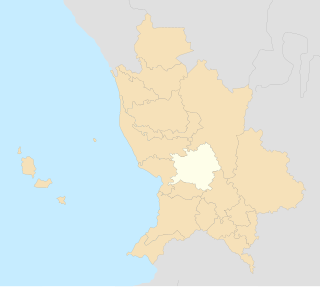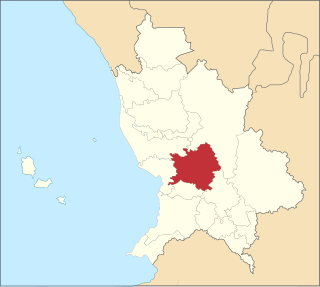Related Research Articles

Tepic is the capital and largest city of the western Mexican state of Nayarit.
Valle de Banderas is a town in the state of Nayarit, Mexico. It is the administrative seat of the surrounding municipality of Bahía de Banderas.

Cruz Bay, U.S. Virgin Islands is the main town on the island of Saint John in the United States Virgin Islands. According to the 2000 census, Cruz Bay had a population of 2,743.

The Mexican Riviera refers collectively to twenty cities and lagoons lying on the western coast of Mexico. Although there are long distances between these cities, they are often collectively referred to as the Mexican Riviera because of their many oceanfront resorts and their popularity among tourists. Cruise ships often visit three or four of these destinations on their longer cruises. In a 2005 interview Stanley McDonald, the founder of Princess Cruises, mentioned:
The call of the "Mexican Riviera" was coined by Princess Cruise Line. Now everyone refers to it as the Mexican Riviera. I believe that it really spoke to the quality and beauty of what people would see down there. We all know the French Riviera -- the Mexican Riviera was something we had in the western hemisphere.

Star City is a small town of 460 inhabitants in Saskatchewan, Canada, approximately 120 km (70 mi) southeast of Prince Albert and 18 km (10 mi) east of Melfort.
El Nayar is a municipality in the Mexican state of Nayarit. The population was 30,551 in 2005 in a total area of 5,100 km². The municipal seat of Jesús María had a population of 1,520 in 2005. El Nayar is the home of the Huichol, Cora, and the Tepehuán Indians have adapted El Nayar.
Jala is both a municipality and a town in the Mexican state of Nayarit. As of 2005 the population of the municipality was 16,071, in a total area of 364.60 square kilometers. The population of the municipal seat of the same name was 9,631.

Acaponeta is both a municipality and a town in the northern part of the Mexican state of Nayarit. The town is located at the geographical coordinates of 22°29′47″N105°21′34″W. The population of the municipality was 34,665 in the 2005 census, living in a total area of 1,667.7 km². The population of the municipal seat was 18,066, the fifth-largest community in the state. The Acaponeta River flows through the town. See maps at and
La Yesca is a municipality and the municipal seat of the same in the Mexican state of Nayarit. The population of the municipality was 12,025 (2005). The population of the town and municipal seat was 356 inhabitants in 2005. The population density was 7 inhabitants per square kilometer, one of the lowest in the state.
Jesús María is the municipal seat of the municipality of El Nayar in the Mexican state of Nayarit in Mexico. The population was 1,783 in 2000.
San Pedro Lagunillas is both a municipality and the municipal seat of the same in the Mexican state of Nayarit. The population of the municipality was 7,155 (2005) in a total area of 520 square kilometers. The population of the town and municipal seat was 3,630 (2005). The population has been declining since 1980 when it was 8,308 inhabitants.
Xalisco is a city and its surrounding municipality of the same name in the Mexican state of Nayarit. The city had a population of 21,899 in the 2005 census while the municipality has an area of 290.6 km² and a population of 42,893. The municipality lies adjacent to the south side of Tepic, the state capital, and is part of the Tepic metropolitan area.

Ahuacatlán is both a municipality and a municipal seat in the Mexican state of Nayarit. It is located in the southeastern part of the state and has boundaries with the following municipalities: in the north with San Pedro Lagunillas, Santa María del Oro and Jala; in the south with the state of Jalisco and the municipality of Amatlán de Cañas; in the east with Ixtlán del Río, Jala and Amatlán de Cañas; and in the west with San Pedro Lagunillas.

Santa María del Oro is a municipality and municipal seat in the Mexican state of Nayarit. It is located in the south of the state and has boundaries with the municipalities of El Nayar, Tepic, Ahuacatlán, Jala, San Pedro Lagunillas, La Yesca, and Xalisco. The population was 21,688 in 2005, with the municipal seat of the same name having 3,314 inhabitants. The total area was 912.90 km².

The Autonomous University of Nayarit is a Mexican public university based in the city of Tepic, Nayarit, that offers secondary education in addition to undergraduate and graduate education. The university offers 15 preparatory schools located across the major regions of the state. The university offers 33 undergraduate degrees and 28 postgraduate degrees. Enrollment at the university level has been rising since 1996.

The Aguamilpa Dam is an embankment dam on the Río Grande de Santiago in the Mexican state of Nayarit, 38 km (24 mi) northeast of Tepic. The primary purpose of the dam is hydroelectric power generation and it supplies a 960 MW power station with water. Construction on the dam began in 1989 and it was completed in 1993 while the power station became operational in 1994.

The Estadio Nicolás Álvarez Ortega is a multi-use stadium in Tepic, Nayarit, Mexico. It is currently used mostly for football matches and is the home stadium for Coras. The stadium has a capacity of 12,271 people and opened in 2011.

The Municipality of Tepic is one of the 20 municipalities dividing the Mexican state of Nayarit; its head city, the city of Tepic, is also the capital of the state.

The Immaculate Conception Cathedral, also known as Tepic Cathedral, is the cathedral of the Roman Catholic Diocese of Tepic in Mexico. It is located on the main square, in the center of the city. It is famous for its Neo-Gothic style architecture.

The Pajarito Mountains are a small mountain range at the southern end of the Sierra Madre Occidental. They are located in the state of Nayarit in western Mexico.
References
- ↑ "Weatherbase: Historical Weather for Huajimic, Nayarit". Weatherbase. 2011. Retrieved on November 24, 2011.